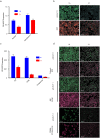Schizophrenia-Associated hERG channel Kv11.1-3.1 Exhibits a Unique Trafficking Deficit that is Rescued Through Proteasome Inhibition for High Throughput Screening
- PMID: 26879421
- PMCID: PMC4754628
- DOI: 10.1038/srep19976
Schizophrenia-Associated hERG channel Kv11.1-3.1 Exhibits a Unique Trafficking Deficit that is Rescued Through Proteasome Inhibition for High Throughput Screening
Abstract
The primate-specific brain voltage-gated potassium channel isoform Kv11.1-3.1 has been identified as a novel therapeutic target for the treatment of schizophrenia. While this ether-a-go-go related K(+)channel has shown clinical relevance, drug discovery efforts have been hampered due to low and inconsistent activity in cell-based assays. This poor activity is hypothesized to result from poor trafficking via the lack of an intact channel-stabilizing Per-Ant-Sim (PAS) domain. Here we characterize Kv11.1-3.1 cellular localization and show decreased channel expression and cell surface trafficking relative to the PAS-domain containing major isoform, Kv11.1-1A. Using small molecule inhibition of proteasome degradation, cellular expression and plasma membrane trafficking are rescued. These findings implicate the importance of the unfolded-protein response and endoplasmic reticulum associated degradation pathways in the expression and regulation of this schizophrenia risk factor. Utilizing this identified phenomenon, an electrophysiological and high throughput in-vitro fluorescent assay platform has been developed for drug discovery in order to explore a potentially new class of cognitive therapeutics.
Figures







Similar articles
-
Trafficking defect and proteasomal degradation contribute to the phenotype of a novel KCNH2 long QT syndrome mutation.PLoS One. 2011 Mar 31;6(3):e18273. doi: 10.1371/journal.pone.0018273. PLoS One. 2011. PMID: 21483829 Free PMC article.
-
Most LQT2 mutations reduce Kv11.1 (hERG) current by a class 2 (trafficking-deficient) mechanism.Circulation. 2006 Jan 24;113(3):365-73. doi: 10.1161/CIRCULATIONAHA.105.570200. Circulation. 2006. PMID: 16432067
-
Trafficking defects in PAS domain mutant Kv11.1 channels: roles of reduced domain stability and altered domain-domain interactions.Biochem J. 2013 Aug 15;454(1):69-77. doi: 10.1042/BJ20130328. Biochem J. 2013. PMID: 23721480
-
Trafficking-deficient G572R-hERG and E637K-hERG activate stress and clearance pathways in endoplasmic reticulum.PLoS One. 2012;7(1):e29885. doi: 10.1371/journal.pone.0029885. Epub 2012 Jan 5. PLoS One. 2012. PMID: 22242185 Free PMC article.
-
A High-Throughput Screening Assay to Identify Drugs that Can Treat Long QT Syndrome Caused by Trafficking-Deficient KV11.1 (hERG) Variants.Mol Pharmacol. 2022 Apr;101(4):236-245. doi: 10.1124/molpharm.121.000421. Epub 2022 Feb 6. Mol Pharmacol. 2022. PMID: 35125346 Free PMC article.
Cited by
-
The ERG1 K+ Channel and Its Role in Neuronal Health and Disease.Front Mol Neurosci. 2022 May 3;15:890368. doi: 10.3389/fnmol.2022.890368. eCollection 2022. Front Mol Neurosci. 2022. PMID: 35600076 Free PMC article. Review.
-
Cellular Models in Schizophrenia Research.Int J Mol Sci. 2021 Aug 7;22(16):8518. doi: 10.3390/ijms22168518. Int J Mol Sci. 2021. PMID: 34445221 Free PMC article. Review.
-
Inhibition of cloned hERG potassium channels by risperidone and paliperidone.Naunyn Schmiedebergs Arch Pharmacol. 2017 Jun;390(6):633-642. doi: 10.1007/s00210-017-1364-5. Epub 2017 Mar 6. Naunyn Schmiedebergs Arch Pharmacol. 2017. PMID: 28265686
-
The schizophrenia- and autism-associated gene, transcription factor 4 regulates the columnar distribution of layer 2/3 prefrontal pyramidal neurons in an activity-dependent manner.Mol Psychiatry. 2018 Feb;23(2):304-315. doi: 10.1038/mp.2017.37. Epub 2017 Mar 14. Mol Psychiatry. 2018. PMID: 28289282 Free PMC article.
-
KCNH2-3.1 mediates aberrant complement activation and impaired hippocampal-medial prefrontal circuitry associated with working memory deficits.Mol Psychiatry. 2020 Jan;25(1):206-229. doi: 10.1038/s41380-019-0530-1. Epub 2019 Sep 30. Mol Psychiatry. 2020. PMID: 31570775
References
-
- Schubert C. R., Xi H. S., Wendland J. R. & O’Donnell P. Translating human genetics into novel treatment targets for schizophrenia. Neuron 84, 537–541 (2014). - PubMed
-
- Harrison P. J. The current and potential impact of genetics and genomics on neuropsychopharmacology. Eur. Neuropsychopharmacol. 25, 671–681 (2015). - PubMed
Publication types
MeSH terms
Substances
Grants and funding
LinkOut - more resources
Full Text Sources
Other Literature Sources
Medical

